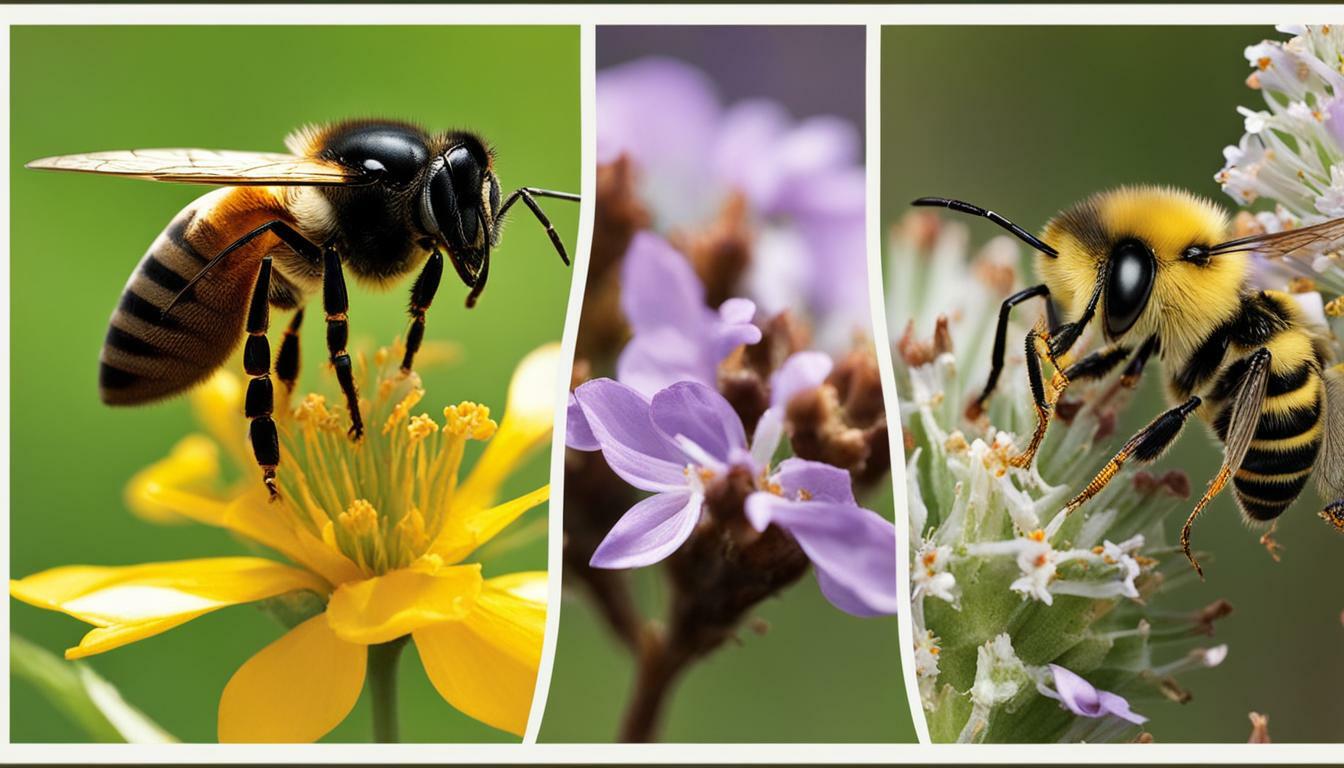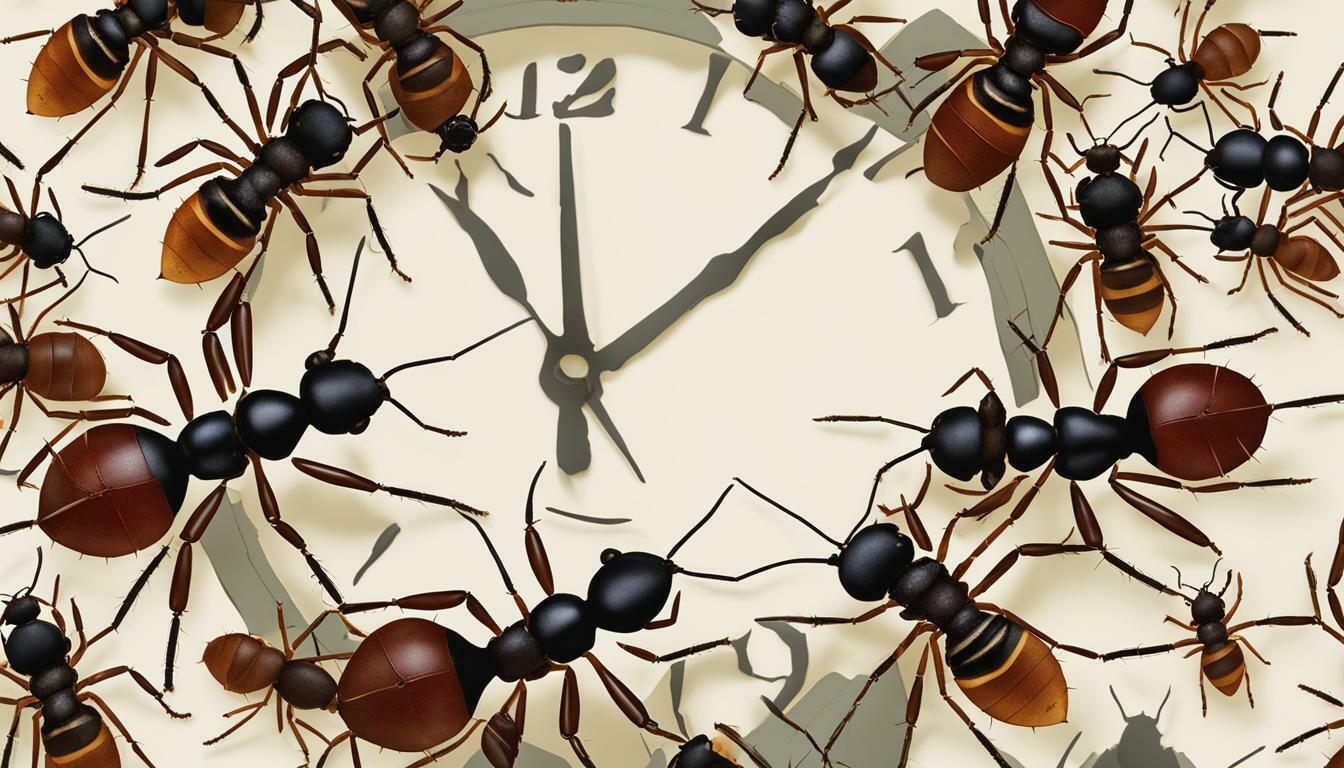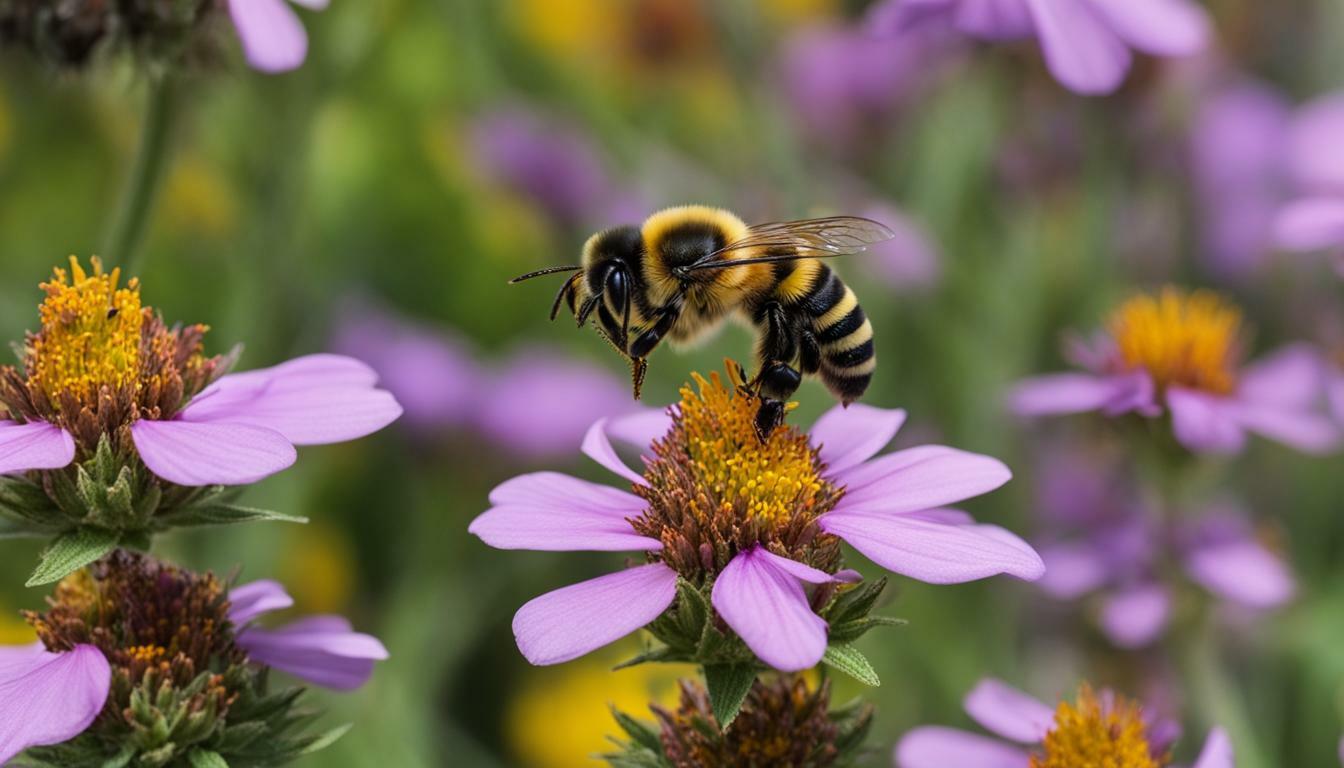Honey bees and wasps are both common insects found throughout the world, and although they may appear similar at first glance, there are a number of key differences between the two. Whether you’re a nature lover, a gardener, or simply curious about the world around you, understanding the unique characteristics, behaviors, and life cycles of honey bees and wasps can help you appreciate the important roles they play in the ecosystem.
Key Takeaways:
- Honey bees and wasps may appear similar, but there are several key differences between the two.
- Understanding the unique characteristics, behaviors, and life cycles of honey bees and wasps can help you appreciate their important roles in the ecosystem.
Honey Bee Characteristics
Honey bees are easily recognizable by their yellow and brown striped bodies and hairy legs. They have two pairs of wings and measure around 15mm in length. One of the most noteworthy characteristics of honey bees is their role as important pollinators in nature. They collect nectar and pollen from flowers to bring back to their hive and produce honey.
Worker bees are able to sting and will do so in defense of their hive or if they feel threatened. However, they will die shortly after doing so due to the stinger being attached to their internal organs. The queen bee is responsible for laying eggs and can live for several years, while drones are male bees whose primary role is to mate with a queen. Honey bees are highly social insects and have a complex communication system using pheromones and dances to communicate with each other.
Wasp Characteristics
Wasps are slender, carnivorous insects that belong to the Hymenoptera order and the Vespidae family. They can be easily identified by their bright yellow or black striped bodies, elongated wings, and thin waist. Unlike honey bees, wasps lack hair on their bodies, and their wings are held flat over their bodies when at rest.
There are over 30,000 species of wasps worldwide, with varying physical characteristics and behaviors. Some wasps are solitary, while others form complex social communities. Unlike honey bees, wasps do not die after stinging and can sting multiple times. Wasps are also known to build nests in various locations, such as underground, in trees, or on buildings.
| Common Wasp Species | Appearance | Nesting Habits |
|---|---|---|
| Yellowjacket wasps | Bright yellow and black stripes | Build paper nests, often underground or in trees |
| Hornets | Large, brown or black bodies with white markings | Build large, papery nests, often in trees or on buildings |
| Mud daubers | Slender, black bodies with long, thin waists | Build nests out of mud, often on walls or under eaves |
According to the National Pest Management Association, wasps are most active during the warmer months and when their nests are disturbed or threatened, they can become aggressive and sting humans or pets.
Overall, wasps play an important role in controlling pest populations and pollinating plants. However, their aggressive behavior and ability to sting make them a danger to humans and pets, especially those with allergies. It is important to recognize the characteristics of wasps and take necessary precautions when encountering them.
Honey Bee Behavior and Life Cycle
Honey bees are known for their highly structured social behavior, which involves a division of labor among the colony’s inhabitants. Queen bees are responsible for laying eggs, while worker bees take care of the brood and foraging for food.
Worker bees communicate with each other through a complex system of pheromones and dances, allowing them to coordinate their efforts. They collect nectar and pollen from flowers to feed the colony and also aid in pollination of plants.
The life cycle of a honey bee begins when the queen lays an egg. After three days, the egg hatches into a larva, which is fed a diet of royal jelly by the worker bees. The larva then pupates and emerges as an adult bee after approximately two weeks.
As the bee ages, it takes on different roles within the hive. Young worker bees tend to the brood and care for the queen, while older workers become foragers and collect nectar and pollen. Drones, which are male bees, hatch from unfertilized eggs and exist only to mate with the queen.
Overall, honey bees play a critical role in pollinating crops and are a vital part of many ecosystems. Their behavior and social structure are fascinating and complex, making them an important insect to study and understand.
Wasp Behavior and Life Cycle
Unlike honey bees, wasps can be either solitary or social insects, with the former preferring to live and hunt alone. Many species of wasps are predatory and hunt other insects as their primary source of food, while others consume nectar and pollen like honey bees.
Wasp behavior can be aggressive, especially when they feel their nests are in danger. When threatened, some species will attack and sting repeatedly, making them a nuisance and potential danger to humans.
The life cycle of a wasp begins with egg-laying, which is usually done inside a nest. The eggs hatch into larvae, which are then fed by adult wasps. After a period of development, the larvae pupate and eventually emerge as adult wasps.
Just like honey bees, the social structure of wasps is highly organized, with specific roles assigned to each individual. Social wasps, like yellow jackets and paper wasps, build nests from materials like mud and paper pulp, while solitary wasps create nests for their offspring out of mud, wood, or other materials.
Stings, Diets, and More: Understanding the Differences Between Honey Bees and Wasps
While honey bees and wasps share some similarities, such as their ability to sting, there are several differences between the two that distinguish them from each other. Whether you’re trying to identify an insect in your backyard or simply curious about these fascinating creatures, it’s important to understand the differences between honey bees and wasps.
Honey Bee Stings
When a honey bee stings, it leaves behind its stinger, which is barbed and can continue to pump venom into the victim even after it has been detached from the bee’s body. This can lead to more painful and long-lasting stings compared to wasps. Moreover, honey bees are less aggressive than wasps and tend to sting only as a defense mechanism or when provoked.
Wasp Stings
Unlike honey bees, wasps can sting multiple times without losing their stinger. Their stingers are also smoother, allowing them to sting more easily. Wasps are generally more aggressive than honey bees and may sting even when unprovoked, making them more of a nuisance to humans.
Honey Bee Diet
Honey bees feed on nectar and pollen, which they collect from flowers and other plants. They play a crucial role in the pollination of various crops and other plants, making them essential to our ecosystem. Additionally, honey bees transform nectar into honey, which is used as a food source for the colony during the winter months.
Wasp Diet
Wasps, on the other hand, are predatory insects that feed on other insects, spiders, and even other arthropods. They play an important role in controlling insect populations, making them valuable to our ecosystem as well.
Overall, honey bees and wasps differ in their behavior, appearance, diet, stinging habits, and much more. Understanding these differences is crucial for anyone interested in studying or identifying these unique insects.
Conclusion
Now that you have a better understanding of the difference between honey bees and wasps, you can appreciate the unique contributions each insect makes to the ecosystem. Honey bees serve as essential pollinators for plants and are responsible for producing delicious honey. Wasps, on the other hand, play an important role in controlling pest populations and are fascinating predators in their own right.
It’s important to be aware of the differences between the two insects, especially when it comes to their stinging behavior. Honey bee stings are generally less aggressive and can only be used once, while wasp stings can be more painful and they can sting multiple times.
Understanding the behavior and life cycle of honey bees and wasps can also help us appreciate the intricate workings of nature. From the social structure of honey bees to the nesting habits of wasps, each insect has its own unique characteristics that contribute to the ecosystem.
So next time you encounter a buzzing insect, take a closer look and appreciate all the amazing things that honey bees and wasps do for the world around us.
FAQ
Q: What is the difference between honey bees and wasps?
A: Honey bees and wasps are different insects with distinct characteristics. While honey bees are important pollinators and produce honey, wasps are predatory and tend to build nests in various locations.
Q: What are some characteristics of honey bees?
A: Honey bees have yellow and brown striped bodies, hairy legs, and play a crucial role as pollinators in nature. They are also capable of producing honey.
Q: What are some characteristics of wasps?
A: Wasps have slender bodies and can be bright yellow or black in color. They are predatory insects and often build nests in different places.
Q: How do honey bees behave and what is their life cycle like?
A: Honey bees have a complex social structure with a queen, worker bees, and drones. They communicate through intricate systems and go through stages of a life cycle from egg to adult.
Q: What is the behavior and life cycle of wasps?
A: Wasps can be solitary or social, and they exhibit aggressive defense mechanisms. They have specific nesting habits and go through stages of egg-laying, larval development, pupation, and adulthood.
Q: How are honey bee stings different from wasp stings?
A: Honey bee stings are barbed and typically stay in the victim’s skin, causing the bee to die after stinging. Wasps have smooth stingers and can sting multiple times. The effects and reasons for stinging may also differ.
Q: What do honey bees and wasps eat?
A: Honey bees primarily feed on nectar and pollen, which are essential for their survival and honey production. Wasps have a predatory diet, feeding on other insects, spiders, and sometimes even human food.
 Skip to main content
Skip to main content


